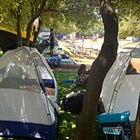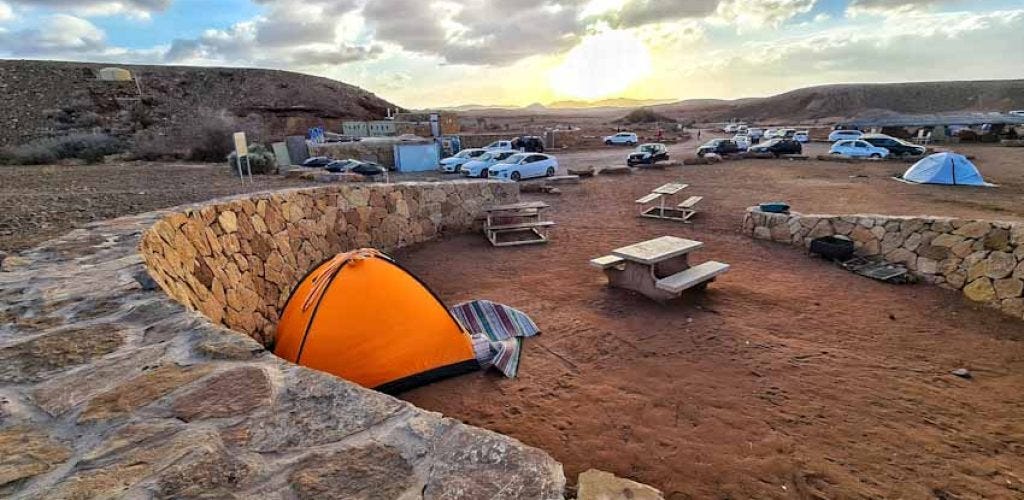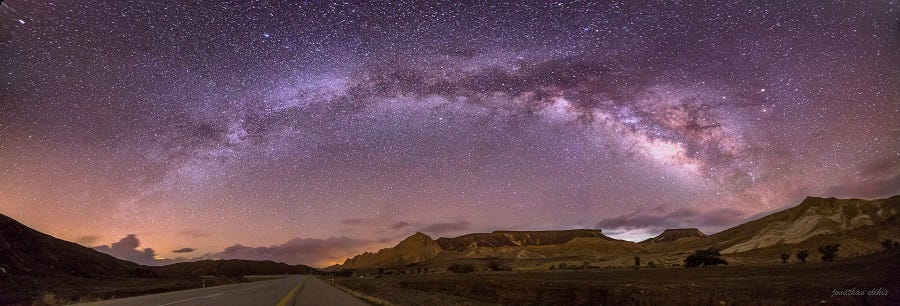Camping Inside the Crater That’s Inside Esav’s Mountain
Although the Ramon Crater is inside the State of Israel, this geographical wonder is not yet biblical Israel - but will be in the future.
Last week I told you a bit about our Golan Heights summer camping last year - and this year’s trip that wasn’t.
Thankfully, we did manage to get away for a night to the relatively safe but boiling hot Negev desert.
Now, the Negev isn’t the simplest place to hike and camp, and in many areas I wouldn’t advise going alone, as I shared with you last summer (which feels like a decade ago) in The Healthy Jew’s Guide for Journeying in Israel.
But one half-exception is the Ramon Crater, a geological marvel located pretty much in the center of the Negev and surrounded by the closed military zones that cover at least half of it.
This geological marvel is basically a huge bowl carved into the desert: 25 miles long, 1-5 miles wide, and a third of a mile deep. On the sides and floor of the bowl are walls of stunning formations of layered colored stones.

But on this visit what struck me most was how organized the place is.
Unlike many of the Negev’s rocky precipices with razor-thin, poorly marked foot paths, many freshly paved roads criss-cross the Ramon Crater, making it relatively easy for anyone to drive deep inside the desert stillness. Even when the pavement ends, from what I saw the trails seemed well marked and easily navigable. There’s even a 7-day circular route that circles around the entire thing.
On the crater floor are lots of designated campgrounds. The one we stayed at, the Be’erot campsite, sports running water, hot showers, and lights that sometimes work. There are also canopies of palm fronds to pitch your tent under (no other shade for miles around), and even a little kiosk.
The entire operation is managed by Israel’s Nature Reserve Authority - and staffed by local Bedouins. The Bedouin are even the security guards. I like that: besides my deep respect for most things Bedouin (more on that another time), they know the desert way better than any Jewish Israeli.
Perhaps one of crater’s greatest draws is the stars - blocked off on all sides from light pollution, on moonlit nights it’s the darkest place in the region. On the night we visited, even though it was close to the middle of the month, we had around an hour after sunset to bask in the white canopy before moonrise switched the sky to dim mode.
As I was lying on the desert floor, I noticed some clouds high above in the dark sky. But they weren’t clouds. It was the stars of our very galaxy, the Milky Way. My phone couldn’t get a convincing picture, but here’s one that someone else took from inside the Ramon Crater.
Late next morning, after the August day was hot enough to make most people think it’s crazy to go outside, I went out for a desert run on a trail that happened to be part of the first-century BCE Incense Route that traders used to bring spices from Asia to the Mediterranean port of Gaza. No big deal.
Out in the middle of nowhere, I felt the desert’s emptiness - and God’s promise that one day His justice will reach all the way here.
You see, as I’ve written about before on The Healthy Jew, and expanded into an in-depth Appendix in my new book, Land of Health: Israel’s War for Wellness, the southern border of biblical Israel is probably the Zin Riverbed which is around a dozen miles north of the Ramon Crater.
What’s immediately south of biblical Israel? Mount Se’ir, which throughout biblical times remained populated by the descendants of Esav (Esau). Mount Se’ir is probably the mountainous region in the center of modern Israel’s Negev that contains the Ramon Crater.1
But Jewish tradition teaches that when the Nation of Israel reaches spiritual wholeness, the biblical Land of Israel’s physical borders will expand to include Mount Se’ir, because Esav’s current homeland is the Kadmoni that God promised Avraham (Abraham).
This is the meaning, we’re taught, of God’s commandment to the Jewish people not to wage war with Mount Se’ir:
“For it is an inheritance for Esav until the foot will step” (Deuteronomy 2:5)
What’s the time that “the foot will step”? When Zachariah’s prophecy (14:4) of the Messiah “stepping foot” on the Mount of Olives will be fulfilled.
In our times of pain and fear in the Land of Israel, we turn to the land and pray to see Obadiah’s prophecy (1:14):
“And the saviors will go up Mount Zion [in Jerusalem] to bring justice to Esav’s mountain, and the [world’s] kingdom will be for God.”
Ironically enough, Israel’s south includes large areas that aren’t part of biblical Israel - just as its northern border ends well before the end of biblical Israel (which is deep inside modern Lebanon and maybe even Turkey.)








I fully enjoy reading about places I've never been and you add a mystical and Godly touch to your descriptions.
Stunning photos!